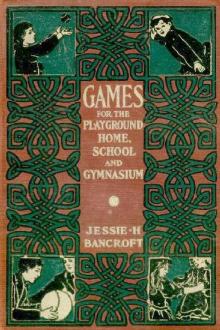Games for the Playground, Home, School and Gymnasium by Jessie Hubbell Bancroft (top novels of all time .txt) 📕

- Author: Jessie Hubbell Bancroft
- Performer: -
Book online «Games for the Playground, Home, School and Gymnasium by Jessie Hubbell Bancroft (top novels of all time .txt) 📕». Author Jessie Hubbell Bancroft
This game is very popular with children.
CENTER CATCH BALL10 to 30 or more players.
Playground; gymnasium.
Hand ball; basket ball; bean bag.
I. Simple form for little children.
All of the players but one stand in a circle, with two or three feet distance between players. The odd player stands in the center of the circle and tries to catch the ball, which is tossed rapidly from one circle player to another. Should he be successful, the one who last touched the ball changes places with him.
II. Advanced form for skillful players.
This differs from the preceding in the greater distance between players and also in the much greater range and resourcefulness of play.
The players stand in a circle with from six to eight feet between each two, and with one player in the center. The circle players throw a ball from one to another, the object of the game being for the center player to catch the ball or knock it to the floor. The circle players may throw the ball over the heads of one another or across the circle, or make sudden feints of throwing it in one direction, turn suddenly and throw it in another, etc., to deceive the center player.
Any player in the circle who last touched the ball, changes places with the center player whenever the latter touches or catches the ball.
CENTER CLUB BOWLS10 to 30 or more players.
Playground; gymnasium.
Hand ball; bean bag.
The players join in a large circle and number by twos or consecutively. The odd numbers form one team and the even numbers (alternate players) another. Three Indian clubs are placed at the points of a small triangle, measuring about twelve inches in the center of the circle. Each player, in turn, bowls at the clubs with a hand ball or bean bag. Each club bowled over scores one for the bowler's team. The team wins which has the highest score when each player has bowled twice, or more times, as may be agreed on at the opening of the game. Each player must secure his ball or bag after bowling and replace the overturned clubs. One ball or bag may be used and passed around the circle, but the play is quicker if each player has his own.
CIRCLE BALL10 to 60 or more players.
Playground; gymnasium; schoolroom.
Hand ball; basket ball; bean bag.
The players stand in a circle with from three to five feet between each two. The game consists of merely tossing the ball rapidly from one player to another, but not in regular order. The sport comes from the unexpectedness with which the ball may be thrown across the ring, or reverse the direction in which it is circling the ring, or in any other way taking the players unaware. A leader or teacher should see that this element of sport is put into the game, or else it may be very dull and useless.
Any player failing to catch the ball should sit down, the player winning who remains standing the longest.
When all are seated, the same game may be played in a sitting position.
For a more advanced form of this game, see Round Ball.
For very little children, the spaces between players should be less and the tossing done in regular order from one player to the next, working up gradually to the more varied modes of play suggested above. Several balls or bags may be used, following each other in quick succession. The number of these may be increased until there is but one (or two) balls or bean bags less than the number of players.
CIRCLE CLUB BOWLS6 to 60 or more players.
Playground; gymnasium.
Basket ball; football; Indian clubs.
The players divide into two parties and take their places in one large circle, the players of one party alternating with those of the other. There should be five or six feet of space between each two players. Each player is provided with an Indian club.
The players of one party distinguish themselves and their clubs in some way, as by tying a handkerchief around the arm and club.
The players, having taken their places in the circle, place each his own club on the floor behind him at a distance of two or three feet. The object of the game is to knock over the opponents' clubs by rolling the ball on the floor, and naturally to protect one's own clubs. Any player may start the game.
While the main form of play for the ball is to roll it, it is permissible to bound the ball from one player to another, and also permissible to knock over a club with a ball that bounds instead of rolling. It is not permissible to toss a ball from one player to another, or to dislodge a club by a toss unless the ball should hit the floor and bound before it hits the club.
Whenever a club is dislodged, the owner of the club must set it up again at once; if he also has the ball, he must set up the club before putting the ball again into play.
A point is scored by one party whenever one of the opponents' clubs is dislodged, whether it be knocked over by a ball or by its owner. The side wins which first makes a score of forty-nine points.
The game may also be played with two balls at once, and this is always desirable for as many as twenty players.
CIRCLE DODGE BALL10 to 30 or more players.
Playground; gymnasium.
Foot ball; basket ball.
All but one of the players form a circle, standing in stride position with feet touching those of the next players to make a barricade for the ball.
The odd player stands in the center and tries to throw the ball outside of the circle between the feet of the players. Those in the circle try to prevent the passage of the ball, using only their hands for this. This play is continued until the center player succeeds in sending the ball through the circle, when he changes places with the player between whose feet or on whose right side it passed out. If a circle player moves his feet in any way, he must change places with the center.
The center player will aid his object by using considerable finesse, appearing to intend sending the ball in one direction, turning suddenly and sending it in another, etc.
When the ball has been sent out of the circle, the players turn, facing outward, and the odd man tries to send it back inside according to the same rules.
CIRCLE ZIGZAGFour forms of this game are given in this volume in alphabetic order. Two are in line formation and two in circle formation, as follows:—
1. Line Club Bowls.—(Single) (Relay formation, one club bowled over.)
2. Line Club Bowls.—(Double) (Relay formation, ball or bag bowled between two clubs.)
3. Circle Club Bowls.—(Ring formation, clubs outside of ring.)
4. Center Club Bowls.—(Ring formation, three clubs in center.)
See also Battle Ball and Bombardment.
CORNER BALL10 to 30 or more players.
Playground; gymnasium.
Basket ball; volley ball.
GROUND.—The ground is marked off into a space measuring at least twenty-five by thirty feet. This is divided across the center by a straight line. In the further corners of each half so made, a small square goal is marked out, there being two such goals in each court.
PLAYERS.—The players are divided into two even parties, each of which takes position on one side of the ground and stations a goal man in each of the goals at the rear of the opposite side.
OBJECT.—The object of the game is to throw the ball over the heads of the opposing party to one's own goal men, who are at the rear of the opponents' court.
RULES AND POINTS OF PLAY.—The players on each side are not bound to any special territory within their own court, but will naturally see that each of the goals at their rear is well protected, and will try to intercept the ball before it can reach these goals. They will also, of course, try to throw the ball over the opposing party to their own goal men in the opposite court. No player may cross the line which divides the two halves of the ground. The goal men may not step outside of their goals. Any ball caught in this way fails to score. No opponent may step inside of a goal. When a goal man catches a ball, he must at once throw it back, trying of course to get it to his own party over the heads of the opponents, who try to intercept it.
SCORE.—Every ball caught by a goal man scores one for the party throwing. The side first scoring twenty points wins the game.
CORNER SPRY10 to 60 players.
Playground; gymnasium; schoolroom.
Balls; bean bags.
The players are divided into four groups, one group stationed in each corner called North, South, East, and West.
Four captains stand in the center, each with a bean bag, facing his corner of players, who stand in a row. The captain throws the bean bag to each player in turn in his group, who throws it back at once to the captain, and so on until the last player is reached. As the captain throws to his last player he calls "Corner Spry!" and runs to the head of the row, the last player becoming captain. The group that first succeeds in having all of its players in the captain's place wins the game.
This game was originated by Miss Amy A. Young of Cleveland, Ohio, and received honorable mention in a competition for schoolroom games conducted by the Girls' Branch of the Public Schools Athletic League of New York City in 1906. It is here published by the kind permission of the author, and of the Girls' Branch, and of Messrs. A. G. Spalding & Brothers, publishers of the handbook in which the game first appeared.
CRACKABOUT10 to 60 players.
Playground; gymnasium.
Soft hand ball.
The players scatter over the playground, trying to get as far away as possible from the one who has the ball. He throws it at one of the players, trying to hit him with it, at the same time calling "Crackabout!" All of the players make a rush for the ball, the one who succeeds in getting it being the next thrower. The other players scatter immediately that one has secured it, the ball man at once throwing at some other player, naturally trying to hit the nearest. As soon as the players hear his call of "Crackabout!" they rush together again in the direction of the ball to try and secure it, and so on indefinitely. The game is thus a rapid succession of running away from the ball man and scrimmages to secure the ball. It is one of the strenuous and popular games enjoyed by boys of almost





Comments (0)